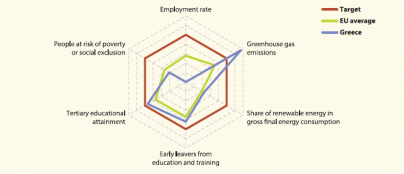Archive:Europe 2020 indicators - Greece
- Data from July 2013. Most recent data: Further Eurostat information, Main tables.
This article is part of a set of statistical articles based on the Eurostat publication Smarter, greener, more inclusive - Indicators to support the Europe 2020 strategy. It provides recent statistics on the Europe 2020 strategy of the European Union (EU), focusing on the situation in Greece.

Main statistical findings

Partly as a result of the economic downturn, Greece reduced its GHG emissions by more than twice its national Europe 2020 target of – 4 %. Tertiary education also developed favourably until 2012, moving the country closer to its target than the EU average. Similarly, Greece was closer to its target of reducing early school leavers than the EU average. As a result of the deterioration in the Greek labour market during the economic crisis, the employment rate was far below the national target. In 2012 the country (together with Spain) was the furthest from its employment target of all the Member States. Further efforts are needed to fulfil the national Europe 2020 commitment concerning the reduction in the number of people at risk of poverty or social exclusion. At 6.4 percentage points from its renewable energies target, Greece also shows further scope for the development of more environmentally friendly sources of energy.
Data sources and availability
More information about the origin of the data and the calculation of indicators can be obtained via the Europe 2020 indicators dedicated website.
Under 'Tables', click on the icons next to the indicators:
- 'Explanatory texts (metadata)' for a detailed overview of the collection and compilation methods;
- 'Information on the leaf' for data availability per country.
A more general overview of quality procedures can be found in Implementation of standard reference metadata for indicators - the ESMS Indicator Profile (ESMS-IP) (PDF file).
Context
Measures implemented to meet the national targets
- Early school leaving: Measures for improving the provision of primary and secondary education; implementation of reforms for the in-service training of teachers; initiation of evaluation and self-evaluation reforms of schools; adoption of different support actions in primary and secondary school.
- Tertiary education: Improving accountability of higher education institutions (HEIs), particularly in terms of funding and budget distribution; improvements in the funding scheme for HEIs; introduction of Institute’s Council taking the responsibilities of the Ministry.
- Employment: Introducing a reform in the minimum wage setting system; promoting flexibility in the labour market to improve collective bargaining, increase business competitiveness and overcome labour mobility barriers; provision of special support for former self-employed; simplification of labour legislation; measures for integrating young people and other vulnerable groups in the labour market.
- Poverty and social exclusion: measures aimed at fighting the social consequences of the crisis by supporting employment and reallocating benefits to the most disadvantaged; reforming the social policy system to increase the effectiveness of social expenditure transfers.
- R&D expenditure: Action plans for supporting new researchers, strengthening the national research system and promoting the optimal use of available resources; strengthening the participation of the private sector in RDI activities.
- Renewable energies: Adopting support measures for the development of renewable energy technologies with high commercial maturity such as wind farms, solar photovoltaic, small hydro.
- Energy efficiency: The National Action Plan for Energy Efficiency, revised in 2008 and 2011, sets out measures for improving energy efficiency in all final energy consumption sectors; energy saving measures primarily targeted towards the transport, tertiary and residential sectors.
The European Commission's 2013 country-specific recommendations
In order to avoid duplication with the measures adopted by the European Commission, The European Central Bank and the International Monetary Fund under the Economic Adjustment Programme, no additional recommendations for Greece were issued in the framework of the European Semester. For more detailed information on recommendations under the Economic Adjustment Programme, see http://ec.europa.eu/economy_finance/assistance_eu_ms/greek_loan_facility/.
See also
Further Eurostat information
Publications
- Smarter, greener, more inclusive - indicators to support the Europe 2020 strategy (online publication, also downloadable as PDF file)
Main tables
Dedicated section
Methodology / Metadata
- Towards robust quality management for European Statistics - Communication from the Commission to the European Parliament and the Council COM(2011) 211 final.
Other information
- Regulation 223/2009 of 11 March 2009 on European statistics